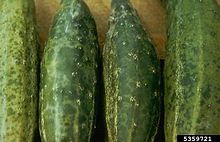
Cucumovirus

Cucumovirus is a genus of viruses, in the family Bromoviridae. Plants serve as natural hosts. There are currently four species in this genus including the type species Cucumber mosaic virus. Cucumovirus is a genus of viruses, in the family Bromoviridae. Plants serve as natural hosts. There are currently four species in this genus including the type species Cucumber mosaic virus. Viruses in Cucumovirus are non-enveloped, with icosahedral and Spherical geometries, and T=3 symmetry. The diameter is around 29 nm. Genomes are linear and segmented, tripartite. Viral replication is cytoplasmic. Entry into the host cell is achieved by penetration into the host cell. Replication follows the positive stranded RNA virus replication model. Positive stranded rna virus transcription, using the internal initiation model of subgenomic rna transcription is the method of transcription. The virus exits the host cell by tubule-guided viral movement.Plants serve as the natural host. Transmission routes are mechanical and contact. It is thought that the Cucumovirus is present worldwide. It is known to occur in Eurasia, Australia, Canada, France, India, Japan, North and South Korea, Morocco, New Zealand, Poland, Spain, the US, and the former USSR. Its natural hosts belong to the domain Eukaryota. The virus is transmitted by vector, mechanical inoculation, grafting, or seeds, and it is transmitted in a non-persistent manner. The vectors may be arthropods, specifically insects of the order Hemiptera, family aphidae (colloquially one would say cucumovirus is transmitted by aphids).
